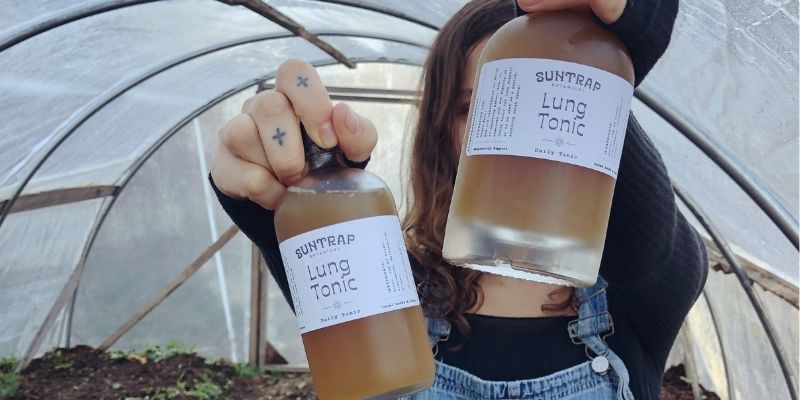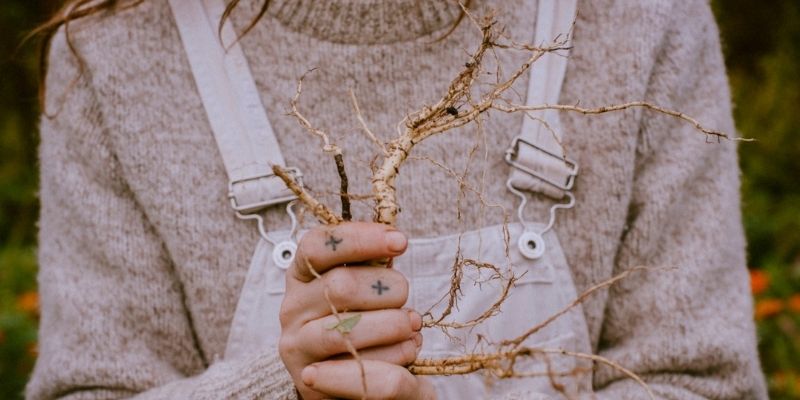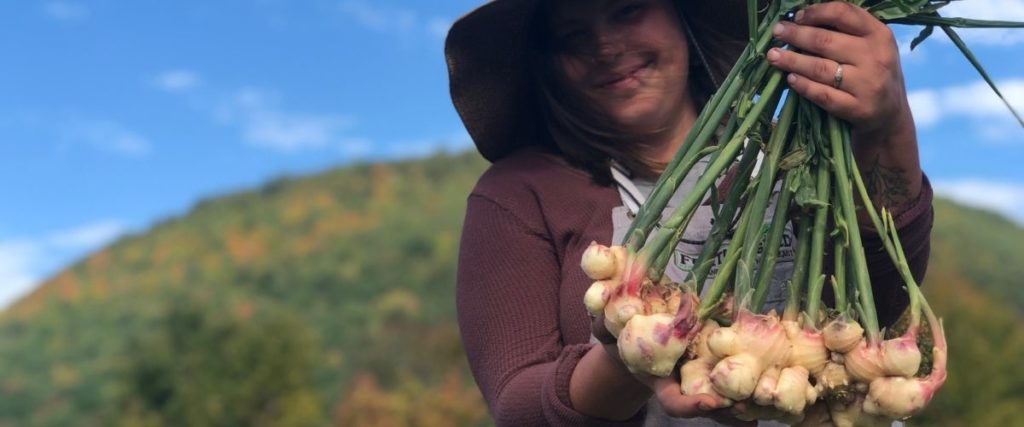Friends, rather than selling and shipping seeds, we now share seeds as an embodied gift practice. Learn how to receive seeds from us & here are our FAQs.
Lung Tonic: Elecampane, Marshmallow & Ginger Cough Syrup
by Geraldine Lavin
part of our bioregional herbalism series with Geraldine of Suntrap Botanical, always ASL interpreted
Sweet respiratory and immune support to be enjoyed daily!
This year instead of shipping my Lung Tonic all over the land, I’m sharing the recipe with you alongside Petra of Fruition Seeds and Kira Avery providing ASL interpretation.
This lung tonic is a strong decoction of marshmallow & elecampane roots from our gardens combined with baby Ginger from our friend’s nearby farm. Petra can help you grow your own! We stabilize the herbal decoction with local, raw honey from a small beekeeper. I am very excited to share this beloved honeyed syrup with my wider community.
Ingredients:
~ 1/2 ounce fresh or dried marshmallow root
~ 1 ounce fresh or dried elecampane root
~ 2.5 ounces fresh baby ginger
1 oz herbs = 1 quart of water
so, 4 quarts of water = 1 gallon of water
~ 2 cups honey
~ optional: licorice and fennel seeds
Simple Instructions:
Toss coarsely chopped roots into water and bring to a boil. Let simmer at least 20 minutes, lid off, allowing water to evaporate, ideally until water volume is reduced by half. Strain the decoction and pour into a jar to cool and measure volume; add equal volume of raw honey and stir to combine. Store in fridge up to one month.
I can’t emphasize enough that this tonic is meant to be enjoyed often! The shelf life is relatively short, so drink this honeyed decoction and be merry! But seriously, I want you to enjoy and be benefitted by every ounce.
I’ve had syrups like this last in my fridge for months, though I give the syrup I sell a 4 week expiration date to be on the ultra safe side. Pop this syrup in the refrigerator as soon as you get it and keep it stored in there.
Dosage:
Shake Well! Separation is natural. Add 1 to 3 tablespoons to still or sparkling water, tea, or whatever you are sipping. We enjoy this as a daily tonic for lung and immune support as well as a gentle, soothing cough syrup. My favorite way to enjoy: 3 tablespoons or so in a quart of warm lemon water, first thing in the morning.
Medicinal Capacities of Marshmallow
Althaea officinalis, Malvacea
Taste: sweet, earthy
moistening, neutral
Harvest
aerial parts (leaves & flowers) on a sunny, dry day when the plant is in peak flower (summer – autumn). Harvest the roots in autumn after the aerial parts die back or in spring before they shoot back up. Marshmallow is a perennial plant, we usually harvest the roots in the second or third year of growth.
The leaves and flowers can be collected all summer, while the root should be dug after the aerial parts have died back in autumn or before the aerial parts shoot up in spring.
Capacities of Marshmallow
The root is a mucilaginous herb with an affinity for mucous membranes. If someone is suffering from a sore throat or a painful UTI, a cold infusion of marshmallow root can be a part of their protocol to ease pain while the root of the imbalance is sorted out. For this infusion, powder the marshmallow before steeping, if possible.
The latin name of Marshmallow tells us a little about the plant’s history. The genus name, “Althaea” derives from Greek for “heal all” while the species name “officinalis” indicated that this particular species of Marshmallow was the official herb used in the European apothecary. Marshmallow belongs to the botanical family Malvacea, which contains many medicinal plants with a common trait of being soothing to irritated tissues such as hibiscus and linden.
Native to the salt marshes of Europe and naturalized in wetlands across North America. When many of the plants on the herb farm were suffering from the endless rainfall of spring 2018, Marshmallow was thriving. Just like the environment it prefers, Marshmallow is a moistening herb. The perfect remedy for dry, irritated mucous membranes, either internally or externally. Many herbalists use the leaves & flowers and roots interchangeably, understanding the root will have a more potent action (with up to 35% mucilage!). Both are demulcent, emollient, and diuretic. However the leaf & flower and roots do have slightly different specific indications. The root is indicated in cases of digestive mucosal irritation and is especially vulnerary when applied to the skin, whereas the leaf and flower are indicated for an irritated respiratory tract when a soothing expectorant is needed.
Medicine Making:
The mucilaginous properties are not extracted by alcohol, so I generally do not tincture this plant. However, I have heard that the tincture can help break down lymphatic stagnation over time.
Generally, I much prefer to dry the herb and use it in teas, cold infusions, decoctions, and syrups.
Cold infusion (best method for extracting mucilage): pour 8 oz cold water over about one tablespoon of dried root, leave overnight. Drink in the morning. Adjust herb/water content to the situation.
Include the shredded root in hot water infusions to balance out drying herbs like nettle. Although you don’t get quite as much mucilage in a hot infusion, you do get a nutrient rich decoction that’s not going to dry you out.
Decoction: put a teaspoon of chopped root in water & boil 10-15 minutes. Drink 3 times a day.
Infusion: for an infusion of the leaf, pour 8 oz boiling water on 1-2 teaspoons of the dried leaf and let infuse for 10 minutes. Drink 3 times a day.
Syrup: decoct roots, strain, allow to cool a little. add honey so the ratio is 1:1, honey to decoction. Stir until combined. Take by the teaspoon daily as an immune enhancing lung tonic. Lately I have been decocting Marshmallow, Elecampane, fresh Ginger, Anise seeds, and Licorice for the syrup recipe to use as an extra potent immune enhancing lung tonic. The syrup will keep in the fridge for up to 6 months.
Medicinal Capacities of Ginger
So fun to say: Zingiber, officinale, Zingiberaceae.
In this lung syrup formula we have Elecampane as our key herbs, Marshmallow as our supporting herb, and Ginger as our catalyst. A formula catalyst is usually a stimulating, pungent, warming, aromatic, herb included in a small amount to help to activate a formula. Ginger is a classic catalyst. My formulas have also included Rosemary and Lobelia (low dose herb!) as catalysts. Cayenne is one as well. Licorice is used as a formula catalyst in many TCM recipes.
As a catalyst, Ginger warms up the formula and helps it move through the body. It is a pungent, aromatic herb with stimulant, carminative, rubefacient, diaphoretic properties.
As a stimulant of peripheral circulation, ginger can also be helpful for moving stagnant blood associated with period cramps
Ginger is also carminative, promoting gastric secretion as well as diaphoretic, promoting perspiration.
Ginger is rubefacient: externally applied to bring blood to the surface of an acute area, ginger brings blood flow to the site of an injury.
Properties of Fresh vs Dried Ginger
I use fresh & dried ginger in my own home kitchen and apothecary frequently. Did you know dried and fresh ginger have distinct properties? Both are warming and drying, but dried ginger much more so. When I am feeling chilled to the bone, or like I might be coming down with something, I run a hot bath and add a few tablespoons of dried ginger. You can really feel ginger’s diaphoretic (sweat inducing) properties this way and the gingery bath is so warming and lovely. Fresh ginger alone holds anti-viral properties that I love to harness when someone around me is fighting off a cold. To do so, I make a decoction of chopped fresh ginger and fresh garlic. I simmer the herbs in water for at least 15 minutes, and then strain and serve with lemon and honey.
Ginger is the go to for an upset stomach, its volatile oil rich aromatic and carminative constituents often settle the stomach. Fresh ginger has anti-inflammatory properties and some studies show it is as effective as ibuprofen for reducing the pain and inflammation associated with arthritis.
Medicinal Capacities of Elecampane
Inula helenium, asteracea
Taste: bitter, aromatic
warming, drying
Harvest
The roots of this perennial plant in the second or third autumn/spring of its life. Before that, it is not ready, after that it has become too woody. In the autumn you should wait until the plant has died back to harvest whereas in the spring you must harvest before the plant shoots its aerial parts up. You may use fresh or dry for later use.
In the first year, Elecampane forms a basal rosette of sturdy, lance shaped leaves. In the second year, and for the years after that, Elecampane shoots up a 3-5’ flower stalk and produces beautiful daisy-like flowers. Plant elecampane on the north side of the garden and give them lots of space, otherwise they are likely to shade your lower growing herbs. Elecampane is native to southern England where it can be found growing in low, damp places. This is also its preferred habitat in north America where it easily naturalizes.
Medicinal Capacities
Elecampane is a first and foremost a lung tonic. It has a warming and drying effect on the whole lung complex and excels at clearing phlegm from deep in the lungs. A preparation of the root is both expectorant and antitussive, meaning it will soothe the cough and help to bring up whatever needs to be brought up. Elecampane is considered a tonic for the respiratory system and can be taken regularly for periods of time to strengthen the entire lung complex. Elecampane is a good choice where there has been chronic irritation in the respiratory system.
In addition to supporting the lungs, Elecampane is also indicated for digestive depression or stagnation characterized by a heavy feeling in the stomach and sluggish transit times. In the lecture, “Botanicals for Chronic Viral Infections” by Kenneth Proefrock, ND, Elecampane is discussed as an herb with potential immune modulation action and anti viral properties. I have also heard elecampane discussed for urinary tract issues, though I have no personal experience with respect to this usage.
Medicine Making:
Elecampane is best taken as a decoction, infused honey, or my favorite: a combination of the two, an herbal syrup.
Decoction: 1 tsp of the herb per 8 oz water. Combined in a pot, covered, brought to a boil and simmered for 15 minutes.
Infused Honey: Slice the fresh or dried root into thin coins and fill a jar halfway with them. Pour honey over the roots up to the fill line of the jar. Turn over the jar daily. Your Elecampane honey should be ready within a week.
Elecampane Syrup: This can be used as a cough syrup for acute coughs or taken as a lung tonic. Bring 1 oz of elecampane syrup (feel free to add fresh ginger) to a boil in 16 oz of water. Simmer for 20 minutes, after which the liquid should have evaporated by about half, leaving you with roughly 8 oz (this is called a decoction). Strain the roots and reserve the water in a jar – allow to cool. Once cooled, add 8 oz honey so you have equal parts decoction and honey. Stir to combine. Take 2 tsp every 2 hours for a troublesome cough.
Sow Seeds & Sing Songs,

& the whole Fruition crew



